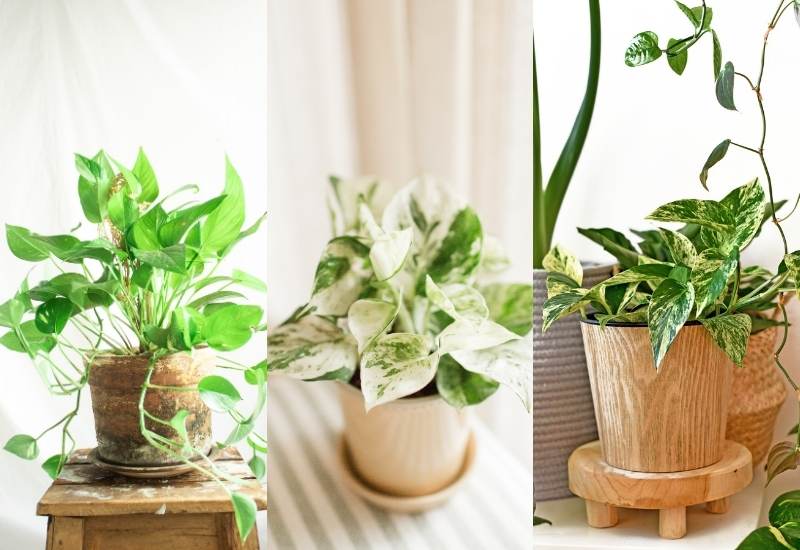
The houseplant pothos, a.k.a. Epipremnum aureum, is a popular species of vines native of Mo’rea in French Polynesia which includes some beautiful varieties and cultivars.
Known as Ceylon creeper, ivy arum, taro vine or devil’s ivy, it is very widespread as an indoor plant thanks to its very low maintenance needs. Its trailing stems with heart shaped leaves are a favorite to drape cupboards, shelves and in hanging baskets.
There is only one natural species of pothos, Epipremnum aureum, but horticulturalists have developed many varieties, which are only cultivars, as there are no pothos hybrids.
Of these, 12 are notable for their great decorative value, like ‘Marble Queen’ and the classical golden pothos.
All pothos varieties share traits but are also different. Thus, this article will help you identify each type, with words and great pictures. But we will throw in some useful tips and information on this very popular houseplant.
Despite the differences, though, they all need the same basic care. We’ll see how you can grow them successfully and then we’ll talk about each one in turn.
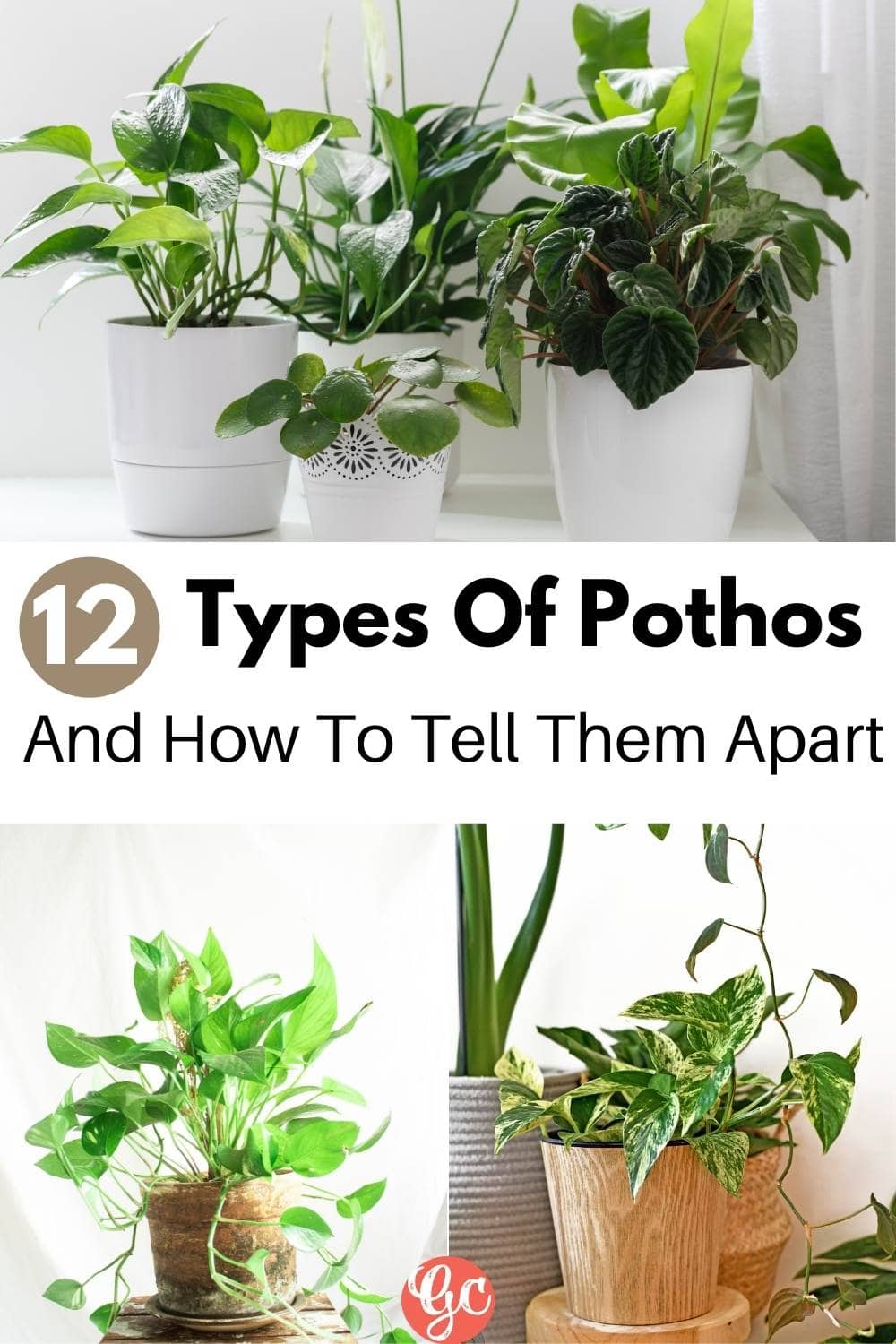
We may earn commission from links on this page, but it won’t cost you extra. We only recommend products we’ve personally used or believe will benefit our readers. Why Trust Us?
How to Care for Pothos Plant
Pothos is very easy to care for. You can literally forget about it on a shelf and it will still give you love in return. However, there are a few tips you will want to follow:
As you can see, it is a very, very, very easy going plant that needs minimum maintenance. And now, get ready to meet all our varieties!
12 Different Types Of Pothos Varieties
To prove you that, contrary to popular belief, there isn’t “just one pothos”, here are 12 different pothos varieties to consider for indoor growing.
1. Golden pothos
2. Marble queen pothos
3. Neon pothos
4. Manjula pothos
5. Cebu blue pothos
6. Jessenia pothos
7. Hawaiian pothos
8. Trebi pothos
9. Glacier pothos
10. N-Joy pothos
11. Satin pothos (or silver pothos)
12. Pearls and jade pothos
1. Golden Pothos (Epipremnum Aureum)
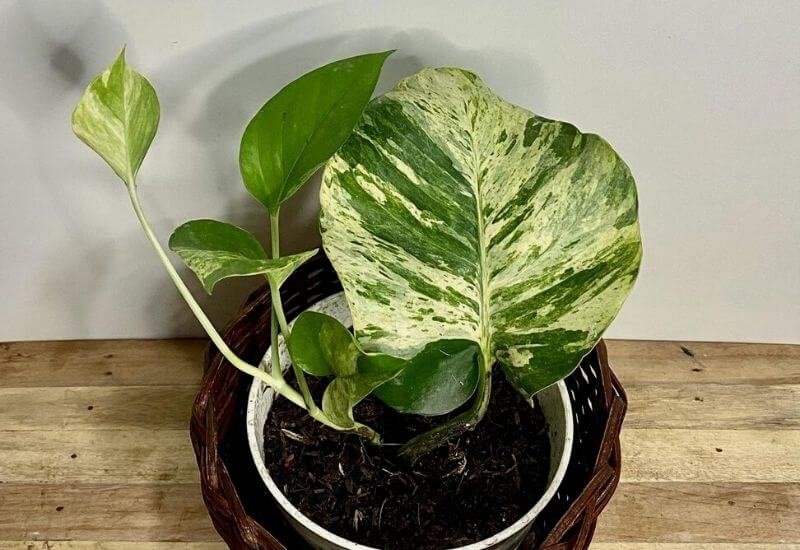
Golden pothos is possibly the most common variety of this houseplant. In fact, “golden pothos” is also used as a general name for the whole species. It is called golden but it is mainly green.
To be precise, it is of a bright emerald green shade but with dabs of cream yellow scattered on the leaves. These give the impression that a painter dashed some paint on the leaf starting from the base.
This is a very easy variety to find and to grow. You will find it in any garden center, online or even in small shops sometimes.
Actually, your friend may have it. Just take a stem and grow your own then. The leaf color is also very stable. This makes it suitable for many types of environments (light conditions especially).
2. Marble Queen Pothos (Epipremnum Aureum ‘Marble Queen’)
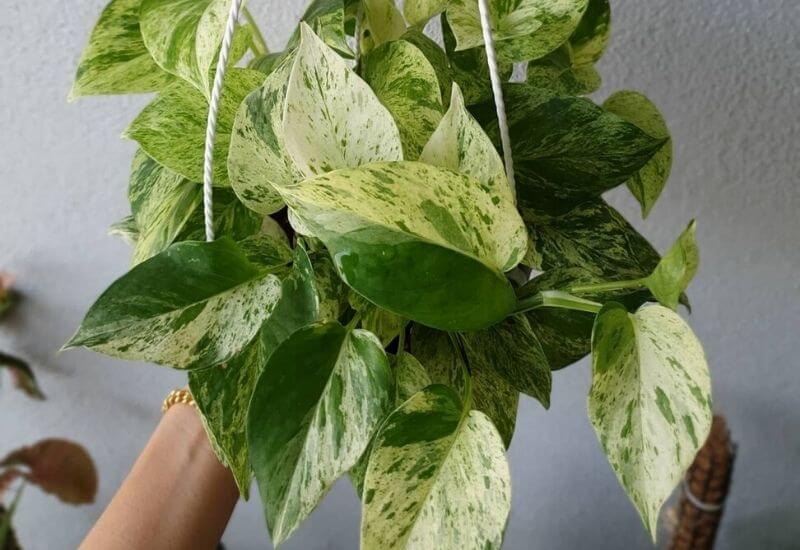
Marble queen pothos is another very popular variety of this tropical vine. One of the earliest cultivars of this plant, it has a different presence from golden pothos.
The leaves, in fact, have marble like patches of white and green. They may be almost 50-50 of the tow colors, or some leaves and plants may have more white or more green.
Because it has little chlorophyll, it grows at a slower rate than other pothos varieties. This and its striking presence make it ideal as a table plant. It has great decorative and sculptural value as a variety.
3. Neon Pothos
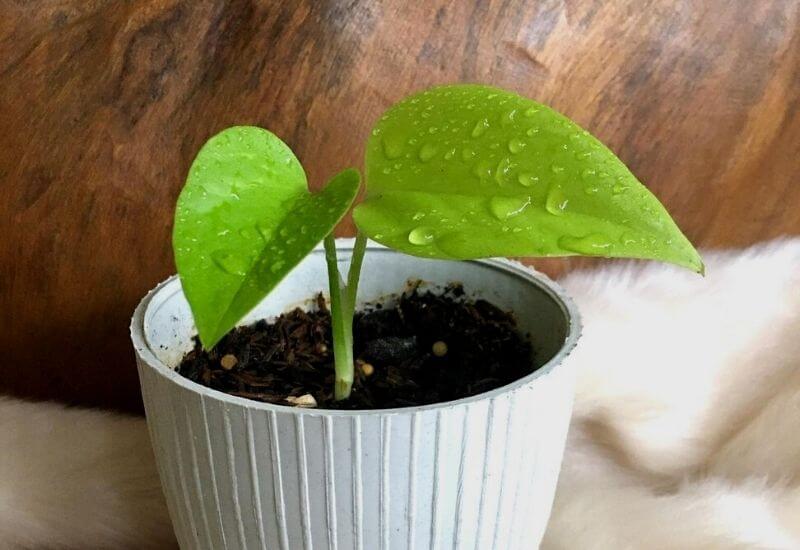
Neon pothos has a “medal” among pothos varieties: it has the most perfect heart shaped leaves of all! But this is not where it gets its name.
In fact, it tales it from a color, neon green, which is that shiny green of the original neon lights (if you are young, they used to be green only, once…) Yes, because the leaves of this variety of pothos are of the brightest green color you will ever see.
Actually the start off a bit lighter and then they turn perfect neon green. As a monochromatic variety, neon pothos certainly makes the best of both shape and color, and this nay be the reason why it is very popular indeed.
4. Manjula Pothos (Epipremnum Aureum ‘Manjula’)
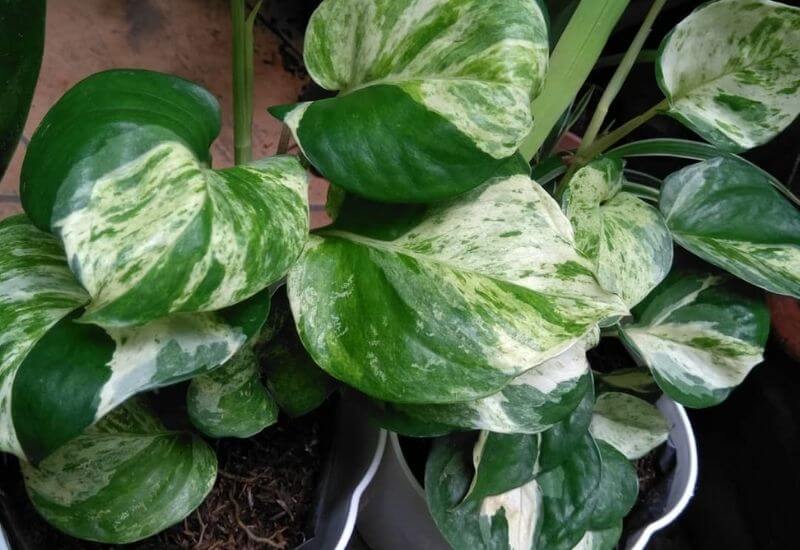
Manjula pothos is an original variety with a peculiar leaf shape. They are heart shaped, but they curve at the tips, and they do not stay flat like with other varieties of this houseplant.
It was bred by the University of Florida, which still holds its patent. This means that you are not allowed to reproduce it.
The leaves are also very striking with their variegated colors ranging from white to green via silver and cream.
These occur in different patterns and with colors overlapping. Some end up looking like abstract paintings or those strange patterns you find on modern looking furniture.
5. Cebu Blue Pothos (Epipremnum Pinnatum ‘Cebu Blue’)
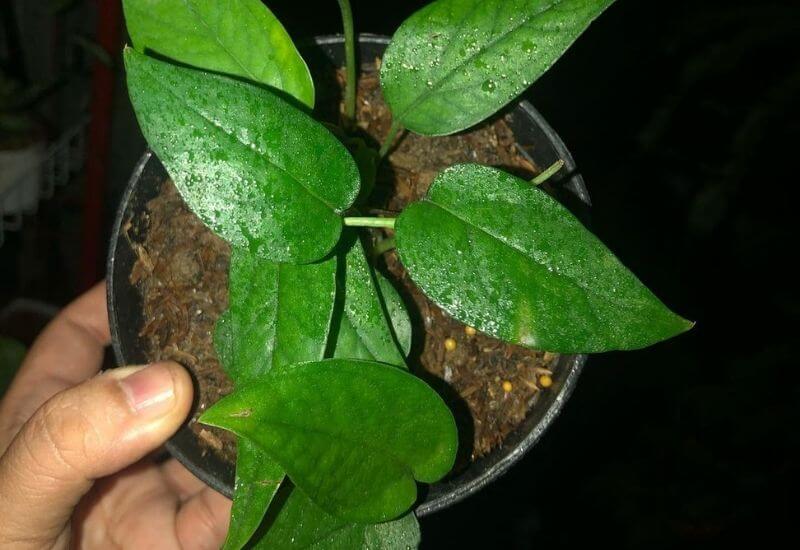
Cebu blue pothos is a variety for plant collectors. It is not easy to find and it is also an “intruder” – let’s say a “guest” – in our list!
You will notice that it does not belong to the species Epipremnum aureum but to Epipremnum pinnatum… But it has become an honorary pothos for gardeners, who in fact, call it so.
It has arrow shaped leaves with a very glossy texture of a rich and fairly dark blue green color. People describe its appearance as “metallic” very often.
The light games are highlighted by veins and bumps on the leaves. These too, set it apart from its botanical cousins (or is it sisters?)
6. Jessenia Pothos (Epipremnum Aureum ‘Jessenia’)
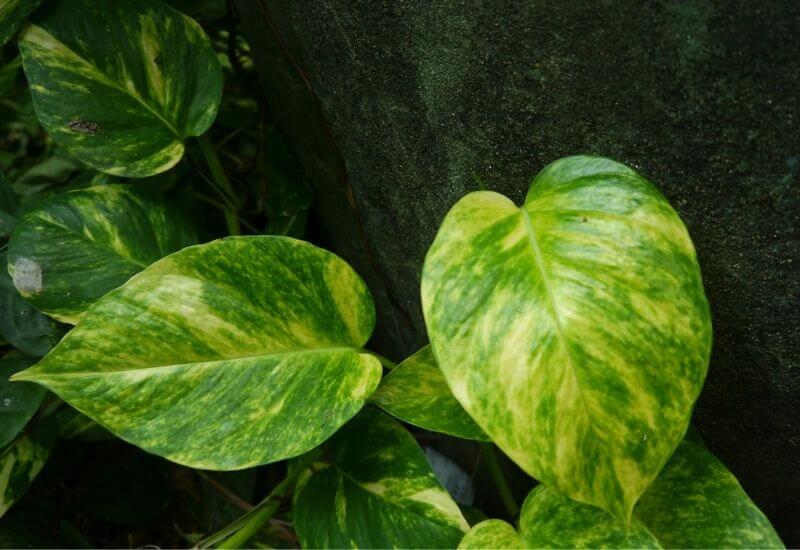
Jessenia pothos is a delicate looking variety. It has variegated leaves, but of two close shades of green.
One is chartreuse and the other is dark emerald. There are also shades in between on many leaves. The patterns resemble that of marble pothos, and you will never find two leaves that are the same.
The color of this variety is quite stable, which, as you know, makes it suitable to different light conditions.
While it does not have a striking appearance, this variety is an “ambience creator” thanks to its light but lush presence.
7. Hawaiian Pothos (Epipremnum Aureum ‘Hawaiian’)
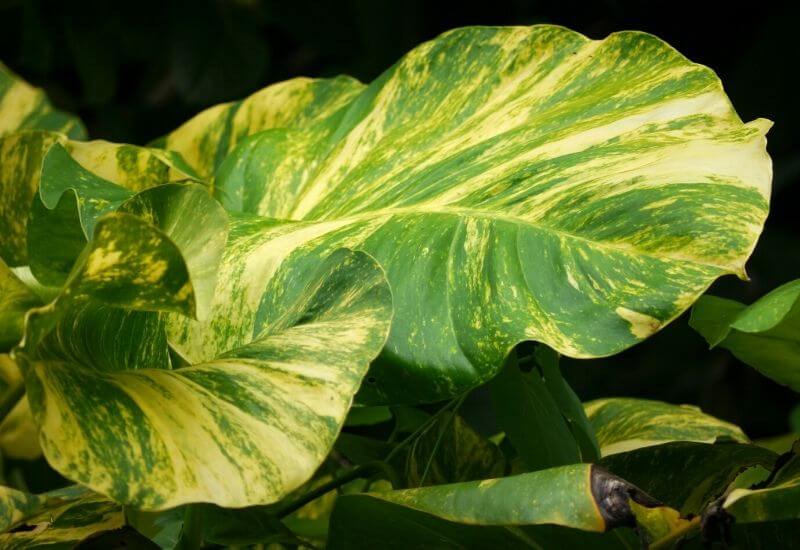
Hawaiian pothos is a very exotic looking cultivar. It has large leaves with a glossy variegated surface.
The main color is rich emerald green, which covers the vast majority of the leaf. But there are dabs of lighter yellow-green dashes that follow the lateral veins and lead the eye to the edges of the leaves.
Ot also grows aerial roots on the stems, which add to its “tropical forest look”.
These, in fact, will remind you of the vines you see in movies on famous explorers, or the ones Tarzan used to swing from tree to tree.
8. Trebi Pothos (Scindapsus Pictus ‘Trebie’)
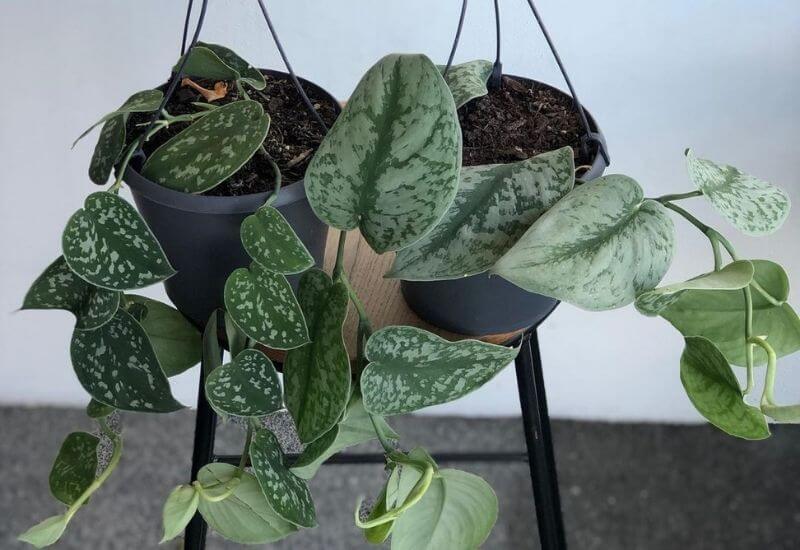
Trebi pothos is another honorary member of the pothos family. Its common name, in fact, hides the fact that it’s not even the same genus.
But in garden centers you will find it with the “pothos” label on it. And in fact it does look like it a lot…
The leaves have a tip that bends sideways, and the heart shape is closer to a lanceolate (the back lobes are not pronounced).
The leaves of this trailing vine have a wonderful pattern of two colors, green and silver green. The green looks like the foundation or base color, and the silver green appears as dots, blots and patches in it.
9. Glacier Pothos (Epipremnum Aureum ‘Glacier’)
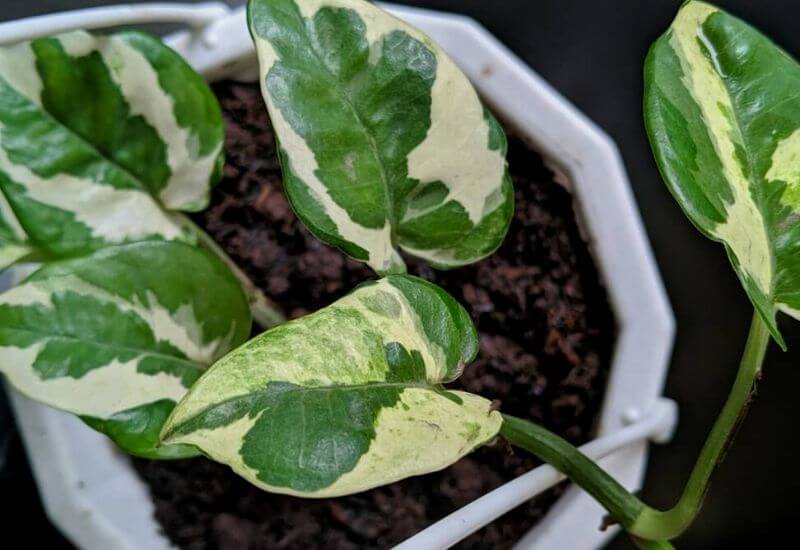
Glacier pothos is a small variegated variety of this vine. This cultivar is becoming very common indeed in garden centers because it has some very striking features.
To start with, it has a fairly compact habit. This and the small size make it ideal for coffee tables and office desks.
But wait, the most beautiful feature is the color pattern on the leaves of this pothos! They have broad, soft looking and well defined patches of cream white and emerald green.
These form very decorative and even sculptural shades on the leaves. No wonder this eye-catcher us the rising star of the pothos family!
10. N-Joy Pothos (Epipremnum Aureum ‘N-Joy’)
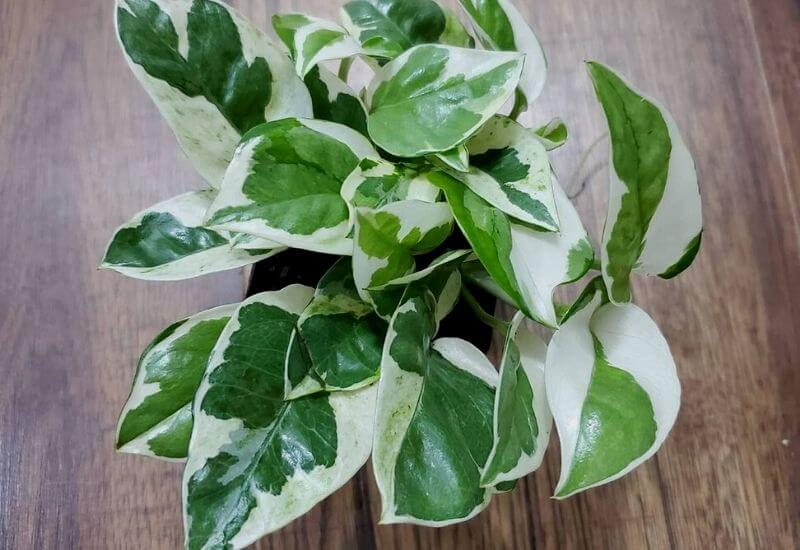
N-Joy pothos is a young member of the group. In fact, this cultivar is one of the most recent ones to have been bred.
It is a variegated pothos variety with clear white and green patches. These tend to be large, drawing like ink sketches on the leaf.
The green will change in shade according to the light and the age of the leaf, from pale green to quite dark.
They often take very interesting shapes. You may see a butterfly on the, or a green ivy leaf painted on white background or a flame inside a heart.
It is very decorative but still you may not find it very easily. But if you do, this is your chance to make an early start with a variety which is set to grow in popularity in the coming years.
11. Satin Pothos Or Silver Pothos (Scindapsus Pictus)
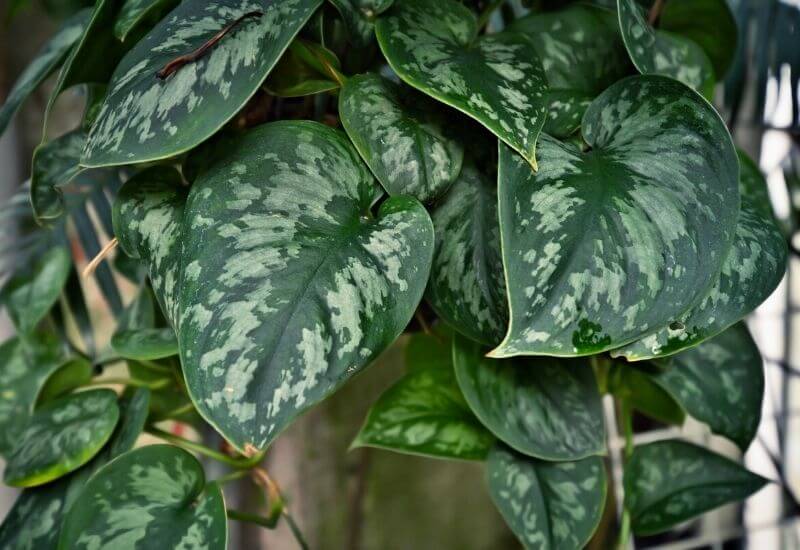
Satin pothos, a.k.a. silver pothos closes the list of guest at the pothos table. This vine is striking in many ways…
To start with, it will bloom occasionally, unlike “actual” pothos plants. And the bloom is quite exotic looking. In fact, it looks like a white pinecone or a strange tropical fruit…
Then, of course, you have the foliage hanging on the trailing stems. It is of a matt green shade with lighter green dots all over.
The effect is actually very decorative. It looks like the dappled light you see from under the canopy of tropical forests. And this completes the striking exotic look of this honorary pothos plant.
12. Pearls And Jade Pothos (Epipremnum Aureum ‘Pearls And Jade’)
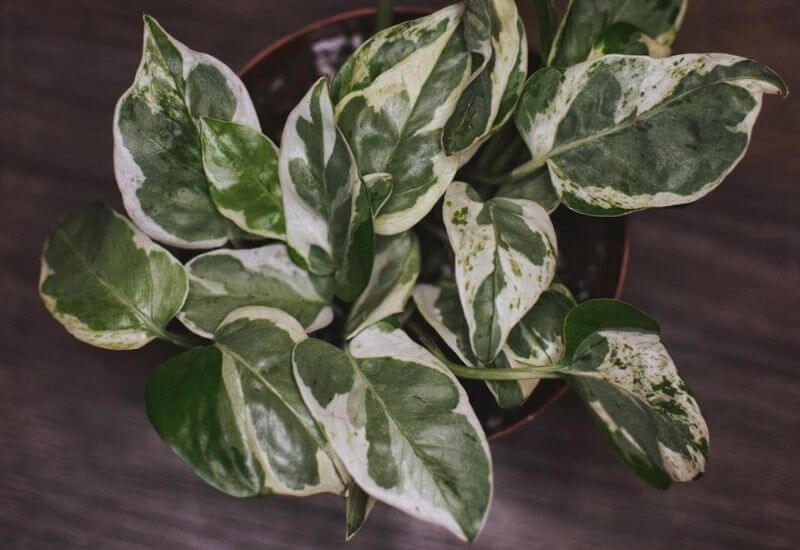
Pearls and jade pothos is one of the most elegant varieties of this houseplant you can find.mIn fact, it has the elegance of butterfly wings or of a silk scarf in the wind.
Why do I say so? The variegation of the different shades of green and the cream white has an oriental touch to it. The figures they paint on the leaf look like watercolors, with smooth transitions.
There are not many areas of color in each leaf, usually one main green at the center, one white one around it and maybe some small green lines around parts of the edges.
But the green, mainly on the jade tone, goes from very bright to very intense and dark. Just stunning.
Beautiful and Useful Pothos Varieties
If you thought that pothos only had “one face and one look” now you know otherwise.
As you can see the different types and varieties of this houseplant are suitable to different places. Not every pothos needs to go on top of that very tall cupboard!
But there is more. I would like to leave you with a fact. Pothos are excellent air cleaners!
They can purify common toxins from the air of your room, especially those that many types of paint and furniture finish give off, like VOC benzene.
So, you get two benefits form this plant: a beautiful room and a healthy room… and for no hassle at all!

Written By
Adriano Bulla
After many years as an academic in London, Adriano Bulla became a writer, publishing books like A History of Gardening, Organic Gardening and Elements of Garden Design; he then decided to become a gardener, following his childhood dream, and has been following his dream writing and gardening professionally in Southern Europe, where he has specialized in new and innovative organic gardening fields and techniques, like permaculture, regenerative agriculture, food forests and hydroponics.

Great write-up and great pics. Visually entertaining and informative.
amazing wonderful,i have 2 types now it can be 12.thank you
Thank you for great informative info and photos of Pothos, I wandered how many inside Pothos there were. I have three and they are very pretty but one has large green leaves with some yellow and shaped into wide hearts, they are almost as large as the Hawaiian Pothos and I didn’t see any here that look like it maybe you can tell me what the name of this Pothos might be.